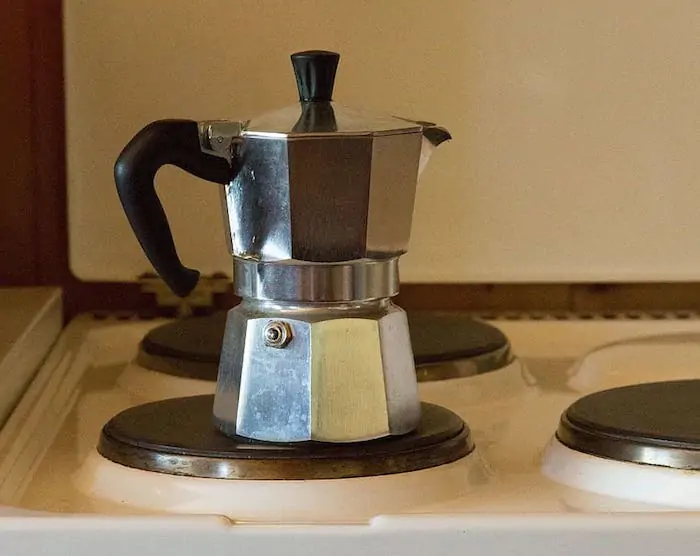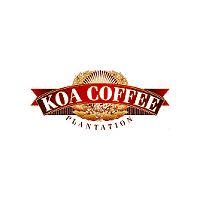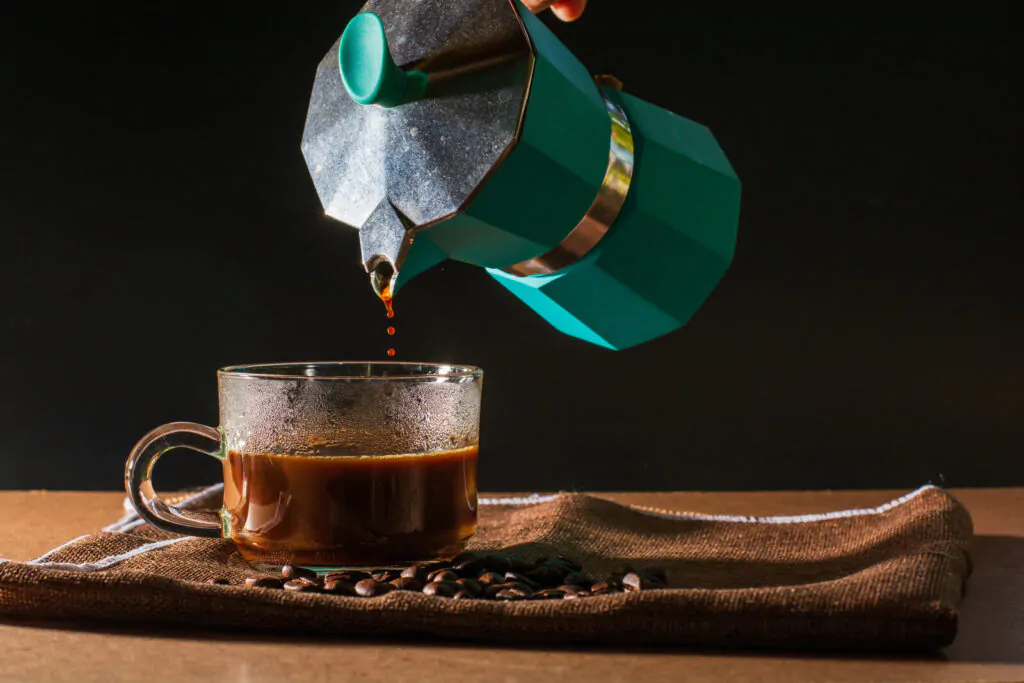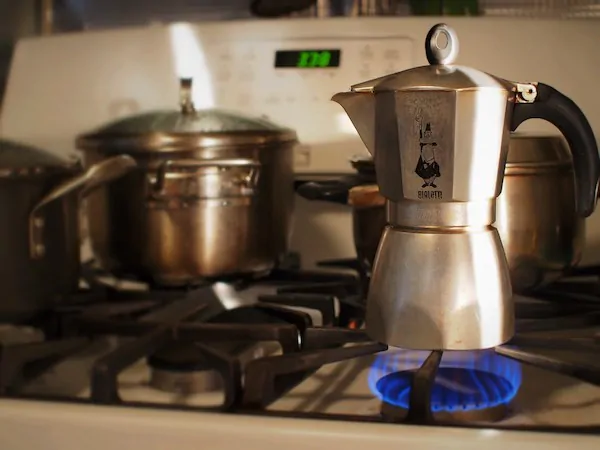If you’ve just bought one, you’re probably wondering can you use a Moka pot on an electric stove? It depends.

A Moka pot, also known as an espresso pot, makes it easier than ever to enjoy an espresso at home, which traditionally called for a more expensive machine to make your favorite espresso drinks.
These pots are made for stovetop use; however, they are most commonly recommended for use with gas stovetops; therefore, if you have an electric stovetop, you may wonder if you can still use your Moka pot on it, which you may.
However, when using the pot on an electric stovetop, be warned that the heat can be a bit harder to control, which can affect the way the coffee turns out, but you can use a heat diffuser to control the heat.
Recommended Coffees
| Brand | Details | Price | Buy Now |
|---|---|---|---|
 | Recommended! Try the tastiest coffee from around the world. Sent straight to your door. Cancel any time. | From $9 per month | Try now |
 | Premium coffee from Hawaii | From $22 | Save With a Triple Pack |
 | High performance coffee drinks | From $24.95 | Shop now |
Moka Pots vs. Espresso Machines
Moka pots are light, aluminum, or stainless steel kettle-like pots that enable you to make coffee directly over a burner.
Like espresso machines, these pots also use steam pressure to push water through the coffee grounds to produce coffee; however, the pressure generated by the Moka pot is much lower than a traditional espresso machine, and the temperature of the water inside the pot also gets hotter, which produces a different taste than espresso.
Instead, the Moka pot produces a richer, stronger-tasting coffee with deep chocolate and caramel tones. It also doesn’t produce as much foam or crema as coffee made by espresso machines.

Since the coffee is made using the stovetop, it produces slightly more bitter-tasting coffee than coffee made with an espresso machine. The coffee also has a higher caffeine content than espresso machine coffee due to the extremely hot water.
Espresso machines and Moka pots also work best with different coffee ground sizes. For instance, Moka pots work best with medium size grounds, while finer coffee grounds are usually recommended for espresso machines.
Moka pots are also inexpensive compared to espresso machines, and they are also easier to use and just as reliable; however, because the coffee made in a Moka pot is made using a lower pressure than an espresso machine, it is technically not the same as espresso, but it can still be used to make a variety of espresso drinks, such as cappuccino, latte, and more.
How Moka Pots Work
Moka pots are designed with three different chambers.
There is a bottom chamber, which is the part that is filled with water. Once the water boils, it builds up pressure in the pot’s lower chamber, allowing it to rise and flow into the middle chamber.
The middle chamber is where the ground coffee is placed. This section of the pot is funnel-shaped to enable the water to reach the coffee, and it also has holes in it, so the water can flow through the middle chamber and so the coffee grounds don’t fall into the lower chamber. Meanwhile, the top or upper chamber, which is also funnel-shaped, allows the brewed coffee to flow up from the center of the pot to the top chamber, where it accumulates.
During this process, the beans are first saturated with water. Once the beans are thoroughly soaked, the steam from the broiler chamber begins to make its way up the funnel, where it becomes cool enough for brewing, after which time the coffee will start flowing.
Moka pots also have safety valves, which provide another outlet for steam to escape in the event intense steam builds up in the lower chamber. They also have gaskets that hold the three chambers together while also preventing pressure from seeping through the openings between the attached parts.
See more details in this video:
Why Moka Pots are Most Recommended for Gas Stovetops
In order to enjoy great Moka pot coffee, it needs to be perfectly brewed, which starts with using the right burner or a burner that enables you to control the heat easily so you can time exactly when the coffee is perfectly brewed.
For this reason, gas burners are most often recommended for Moka pot coffee because the open flame allows you to control the heat very well.
On the other hand, electric burners make it more difficult to manage the heat or perfectly time the brewing process because there is no flame to gauge how hot the burner is; therefore, it can get too hot, which can cause the coffee to become over-extracted and, therefore, cause it to have a burnt taste.
Aluminum Moka pots like this are especially not recommended for electric stovetops because since they are so lightweight, and because aluminum is a good conductor of heat, it is even more important to control the heat to prevent it from getting too hot and too quickly, which can ruin the coffee’s taste. Likewise, they are also not recommended for use on induction stovetops.
Meanwhile, stainless steel pots have the opposite problem; they don’t conduct heat well so they may be more compatible with various stovetops. However, because they are not good conductors of heat, they can also cause uneven heat distribution, which can cause uneven extraction and affect the taste.
There are also newer model Moka pots that are designed with aluminum and stainless steel elements for use with gas and electric stovetops. Therefore, If you have an electric stovetop, you may consider investing in a newer model pot for the best results.
If you have an electric stove, you can also use a heat diffuser like this to help control the heat.
Proper Moka Pot Brewing Methods

Just as important as ensuring the proper heat when making coffee in a Moka pot, it is equally important to ensure the proper brewing techniques, which come with trial and error.
One of the biggest issues outside of ensuring the proper heat temperature for your Moka pot is timing the brewing process. If you remove the pot from the heat too soon, you will have under-extracted coffee, which produces a very strong taste. On the other hand, if you leave the coffee to brew too long on the stove, the water temperature gets too hot, which causes the coffee to become over-extracted, which gives it a burnt taste.
However, perfectly timed coffee is fully extracted, which leads to a better-tasting coffee. This means you have to remove the pot as soon as the coffee starts to flow in the upper chamber; you should hear the coffee begin to bubble out, after which time the pot is hot enough to finish the brewing process on its own. The brewing process is complete once the top chamber is filled with coffee and only steam is observed coming from the spout.
It is also important to ensure the proper pressure in the funnel filter in order to allow the water to climb up into the top chamber. For instance, not adding enough coffee allows too much water to pass through, which will cause the coffee to be under-extracted, resulting in a watery black coffee with a bitter taste. Filling the filter with too much water, or above the fill line, also affects the pressure because it prevents the water from being able to pass through, which causes too much pressure.
The size of the coffee grounds can also affect the pressure. For instance, grounds that are too coarse can allow the water to pass through too quickly, which can decrease the pressure. They should be as fine as you would grind for espresso, which should feel like sand or salt.
When brewing stovetop coffee, you must also ensure the base is situated perfectly over the burner to help distribute the heat around evenly. Otherwise, if one side of the pot gets hotter than the other, it will result in an unevenly extracted brew. It can also allow the gaskets to become burned on one side, which can cause you to have to replace the gaskets more frequently.
FAQs About Using A Moka Pot On An Electric Stove
Which Is The Best Type Of Moka Pot, Aluminum Or Stainless Steel?
Which is the best type of Moka pot depends on the user; however, aluminum Moka pots are the most commonly used because they are lighter and cheaper than steel pots, and they also distribute heat more evenly.
Stainless steel pots, on the other hand, don’t conduct heat as efficiently, which may make them more compatible with various stovetops, and they are also said to be safer than aluminum pots, which may release traces of aluminum into your coffee. Since stainless steel pots are more durable, they last longer than aluminum ones.
How Can I Ensure Good Coffee With My Moka Pot While Camping?
The same rules apply for making good coffee with a Moka pot in nature as it does when you are at home. This means you should still aim to select a burner that enables you to easily control the heat in order to perfectly time your brew. Therefore, steer clear of electric burners while camping, and opt for a propane burner instead, which, similarly to a gas stovetop, gives you more control over the temperature, so you can perfectly time your brew.
Or, if you have already invested in a Moka pot that is made for both electric and gas stovetops, then, by all means, you can use either type of burner with good results.
About How Long Does It Take Coffee To Brew In A Moka Pot?
Once you have assembled the Moka pot, place it on the stovetop over low to medium heat. If you use cold water to fill your pot, it can take about 6 to 8 minutes for your coffee to brew, depending on whether you are using a gas stovetop or an electric stovetop.
However, if you fill the pot with hot water, you are looking at a brewing time of about one to two minutes. Remember, once the coffee begins to flow into the top chamber or you hear a gurgling sound coming from the pot, quickly remove it from the heat to prevent over-extraction.
Can you use a Moka pot on a glass top stove?
On a stove with a glass top, you can use a Moka pot. The Moka pot, a stovetop espresso maker, is one of the most straightforward yet premium coffee makers.
Can you use a Moka pot on an induction stove?
An induction stove is not compatible with a standard Moka pot. Because aluminum is typically used to make Moka pots, which are not magnetic, they cannot be heated by induction. Use an adaptor or a specific Moka pot made for induction stoves as a solution.
Can you use Moka pot on a coil stove?
You can use a Moka pot on a coil stove, but you must use the burner best suited for your pot or position it so that the handle is out of the heat’s path. Compared to an electric stove burner, gas flames are considerably simpler to level-adjust and control.
